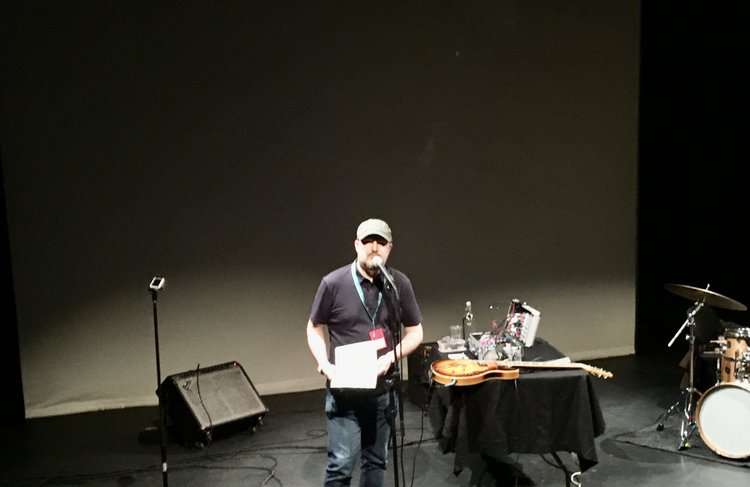Spread over two days held at the Project Arts Centre and the Ark in Temple Bar, Jazz Connective came to Dublin after Ljubljana, Łódź and Helsinki – with Birmingham, London and Lyon next up.

Supported by the EU under the Creative Europe Project, these two days of events encompassed workshops, a round table discussion moderated by Cormac Larkin of The Irish Times, and a programme of concerts programmed and produced by the Improvised Music Company (IMC).
The opening Space Is the Place workshop after an introduction by Kenneth Killeen of the IMC drew on Finnish and Polish experiences. Annamaija Saarela, curator and chief executive officer of G Livelab Tampere, described her beautiful looking new musicians union-owned venue and its vision for the future, while Martyna Markowska of the Katowice Institute of Culture touched on an overview of the Polish jazz scene and a discussion ensued among the delegates that drew on a range of shared experiences across Europe.
Later in the first of the live music performances drummer Steve Davis and guitarist Shane Latimer performed a late-afternoon freely improvised set that drew on Davis' interests in multi-directional drumming while Latimer injected a universe of electronics generated from a bulging box of wires and hooked up to a tiny keyboard that created a futuristic sound that spanned improv and electronica as the interplay between the duo developed in a relatively short length of time.
The evening triple bill began with the duo of pianist Izumi Kimura and violinist Cora Venus Lunny that was almost classical in its discipline and mood, Kimura very detailed and exact no matter how abstract the improvisations became.
Later hearing Laura Jurd play solo trumpet was a first for any Dublin audience and she showed her ability to vary her improvising points of departure whether using foot generated effects or utilising cup or harmon-type mutes.
Finnish power trio Mopo distilled energy in a livewire feat of derring do with Linda Fredriksson on baritone and alto saxes in particular injecting a flurry of detonations skilfully shaped by Eero Tikkanen who switched from bass guitar to double bass and back again as the set developed and the trio's collective energy fizzed and sparked their own motion.
The creating and developing jazz for young audiences workshop on the second day was led off by Eva Frost, director of JazzDanmark, who spoke of the Danish JazzCamp for Girls, and also featured Aisling O’Gorman of the Ark Children’s Cultural Centre in Dublin where the workshop was held who spoke of the Ark's 25-year history and collaborations there that have included past work with the IMC.
Later at the Project Arts Centre the children's orientated improvised project String Play was a fun piece of inventiveness featuring Mary and Katherine Barnecutt on strings and Matthew Jacobson on drums. The kids in the audience were very enthusiastic listeners and at times participants as they stomped their feet and leaned forward to get a closer look at the performers who merged theatricality with improvisation in a very organic manner.
At the round table open discussion led off again at the Project by contributions from a panel featuring Matt Jacobson, Annamaija Saarela, Eva Frost and Martyna Markowska questions from the floor were asked often revolving around issues concerning the fractured Irish jazz scene and the lack of a unifying focus or hub.
A range of observations arose from the floor. Musicians who spoke included Linley Hamilton, Barry Donohue, Tommy Halferty and Chris Guilfoyle while festival organisers who contributed included Dorothy and George Jacob of the Bray Jazz Festival and John Daly of the Limerick Jazz Festival.
The triple bill in the evening began with a solo piano series of free improvisations from Elliot Galvin that proved the easy highlight of the whole two-day affair, Galvin using prepared piano ideas to achieve striking outcomes and his improv (all pieces not on the new record he noted a tad impishly) spanning huge detail and power in its execution was state-of-the-art piano avant garde.
Steve Davis and Shane Latimer returned this time to play collaboratively in trio mode with Mopo saxophonist Linda Fredriksson and this worked best in the duo episodes between Davis and Fredriksson, the latter's power and incredible technique turning up the drama and heat of the performance an extra notch with its punky intensity and in the moment ideas.
Bex Burch's Vula Viel were the final act of the live performance segment of Jazz Connective in Dublin, Tom Herbert of The Invisible on bass guitar appearing on this occasion in the band instead of Ruth Goller. Jim Hart on drums was a dazzling presence and Burch showed great strength and power as she explored her inventive improvisational and compositional ideas on the unusual gyil.
Report + pic: Stephen Graham
Top, Kenneth Killeen introducing the acts
Tags: